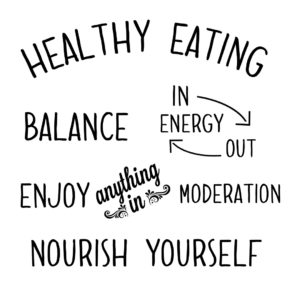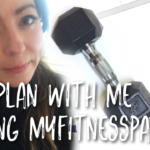 Personal trainers have varied approaches to discussing nutrition; some give you a one-size-fits all meal plan, some recommend Paleo, Whole30, or whatever else has caught their eye, and some refuse to discuss it at all. I choose to fight this battle out alongside my clients because I know that nutrition is important for reaching and maintaining their goals (and for feeling great along the way)…and I don’t use that term “battle” lightly!
Personal trainers have varied approaches to discussing nutrition; some give you a one-size-fits all meal plan, some recommend Paleo, Whole30, or whatever else has caught their eye, and some refuse to discuss it at all. I choose to fight this battle out alongside my clients because I know that nutrition is important for reaching and maintaining their goals (and for feeling great along the way)…and I don’t use that term “battle” lightly!
Nutrition can often be more of a struggle than the working out part of training to reach your goals because you have to eat every day and I’m not there with you in person the way I am during your workouts, so whether you’re my client or not, here is a little list of what I think healthy eating is (click the graphic for a bigger version if you want to print it or save it as your phone background).
Nourishing your body to have energy for your life, as well as your workouts.
I didn’t design the human body, but I can tell you that it’s not able to handle processed carbs as its main “nutrition” source, mostly because they contain no nutrition! Finding a balance of foods that includes whole or minimally processed goodness will help you feel great inside and out, and probably balance out those afternoon slumps.
If you don’t eat enough, your metabolism slows down. It’s not trainer science, it’s real science. You have to eat in order for your body to function, and your brain consumes most of your calories anyway. You don’t have to learn to love green smoothies, but you do have to offer your body something besides sugar (harder than it sounds for many people, but that’s for another post).
Lifelong strategies to balance your energy in and out.
If you go on vacation and eat the entire buffet all day every day, you may find that your clothes fit a little differently when you get home. I want you to know how to fix that through healthy nutrition strategies, not ineffective quick fixes like juice cleanses or whatever other weird restriction is in style when you’re reading this post. As your lifestyle changes through aging, job changes, and all of the other big events that life can throw at us…and your metabolism changes right along with it…I want you to know how to handle that, too! And finally, when you reach your goals, I want you to know how to maintain them (which, if you’re my client, looks a lot like what you were doing in order to reach your goals in the first place, just with an extra snack or so each day).
Flexible eating that allows you to enjoy whatever you want in moderation.
Restricting sets you up to fail. Need proof? No one steals the gravel from my garden, but if I replaced it with diamonds, how quickly do you think they’d run off? We see gravel every day, but diamonds are set apart, scarce, and valuable – and so exciting and sparkly! If you turn all of your favorite foods into diamonds, you won’t be able to resist the lure of all that delicious bling.
This is why it’s so important to me (and, um, your body…science) that what you do to lose weight/gain muscle/reach your goals is enjoyable, sensible for your life and tastes, and easy to maintain for the long haul. I don’t want anyone to feel that they can “never” eat certain foods or food groups again unless there’s a medial reason for that decision, so we talk about macronutrient balance from the get-go to start understanding what works for everyday eating and how to fit in your favorite special occasion foods without sacrificing any of your progress.
Moderation isn’t a prettified code word for restriction – it just means understanding what portion sizes will help you and which ones will work against your goals.
This isn’t too good to be true.
Just like you can’t buy a new ferrari every day, you can’t eat cake after every breakfast and dinner – but you can definitely have it when you balance it into your life. When combined with the right fitness training for your current lifestyle, your strong and healthy metabolism will be way more forgiving of the occasional I-boxed-these-leftovers-to-go-but-ate-them-in-the-car moment or the I-am-definitely-eating-my-feelings bag of cookies. And, in the long run, I think that’s what everyone wants: the power to basically eat whatever you want, because you know how to balance your day and correct your course when needed. No more panic about your jeans size, no regret and anguish as another summer passes while you hide from every social event, and no weird specialized ingredients or 12-hour cooking marathons.
How do we get there?
I use MyFitnessPal with my clients because it’s helpful for both of us to have data to back up our decisions. Everyone’s body is unique, so while I can tell you that I start the majority of my clients at a 40/30/30 macro balance and a baseline energy intake that’s based on their BMR and anticipated activity level, I don’t have a list of of foods they should eat and not eat, restaurant choices the are THE BEST or THE ONLY meals, or predictions of what will be easy for them to cook or what will throw their life into temporary chaos while we are working together.
However, I don’t plan for anyone to track their food intake forever! After a few weeks or months, most people get a sense of what does and doesn’t work for them to reach their goals, and they can then hop back into the app only when they want help adding new recipes to their rotation or understanding why their body has changed in some way.
Choose to give yourself the best.
Make time to feed yourself – if you wouldn’t starve your pet or give it whatever scraps you find laying around, don’t treat yourself that way either <3



Great Post!! Great Wisdom!!